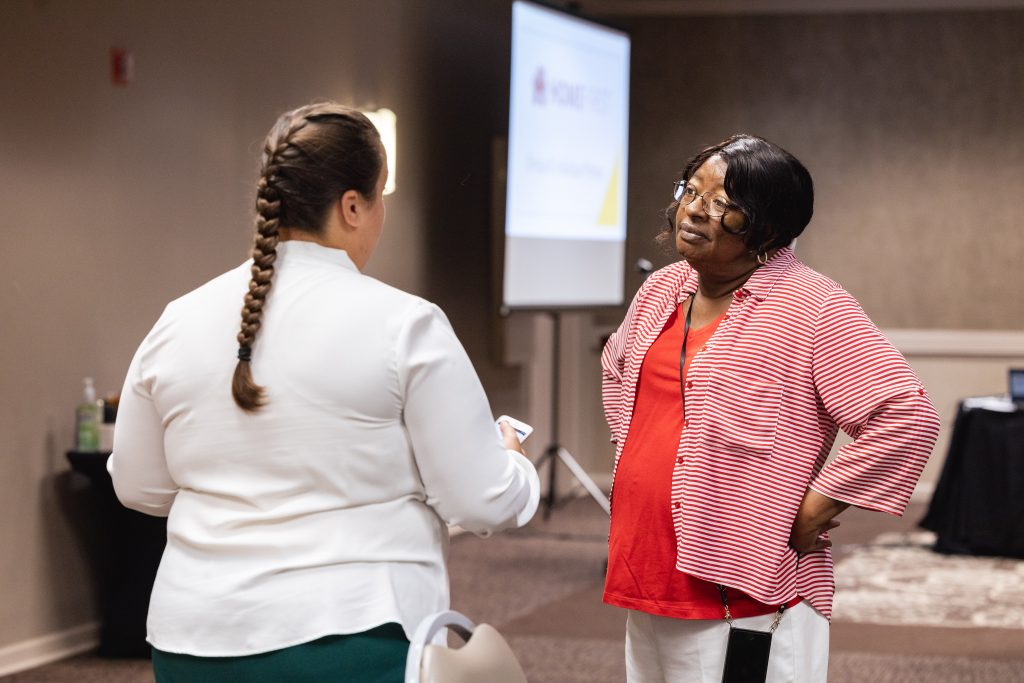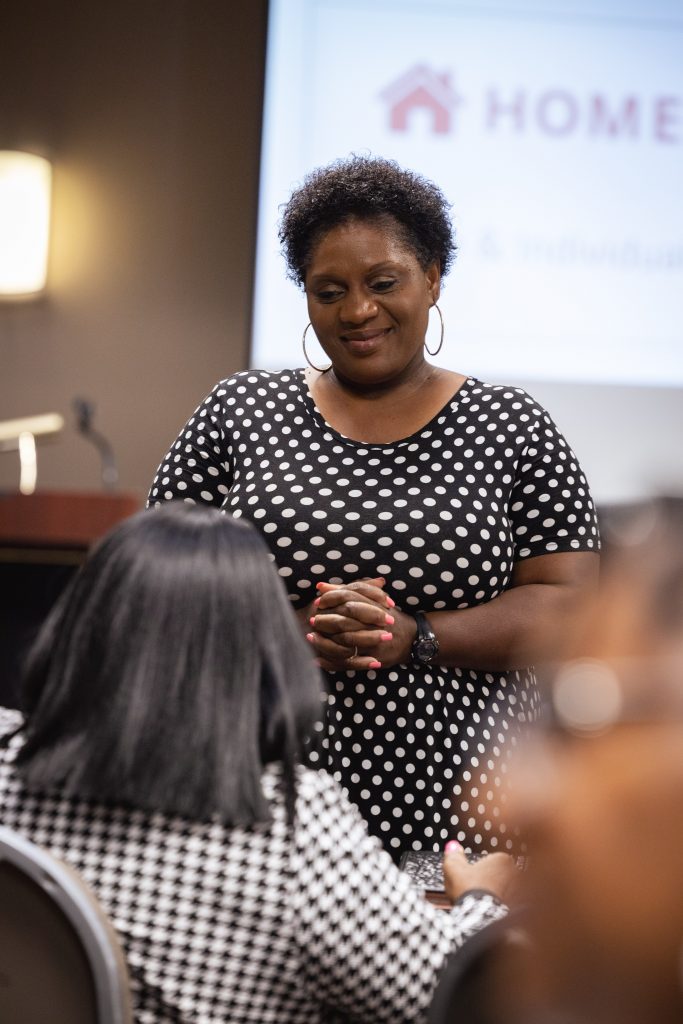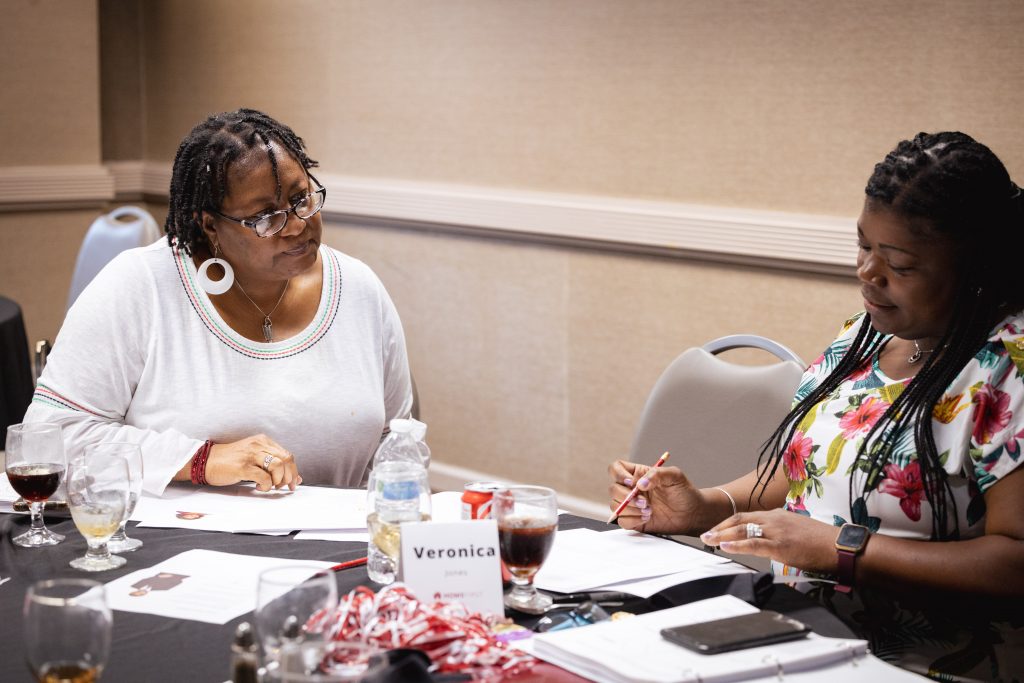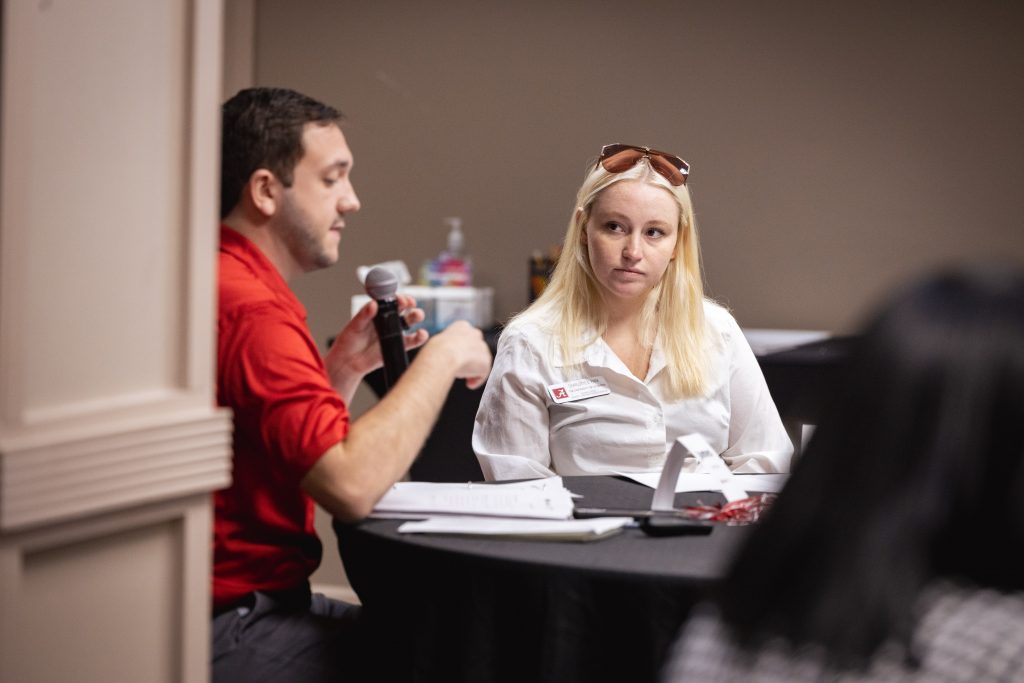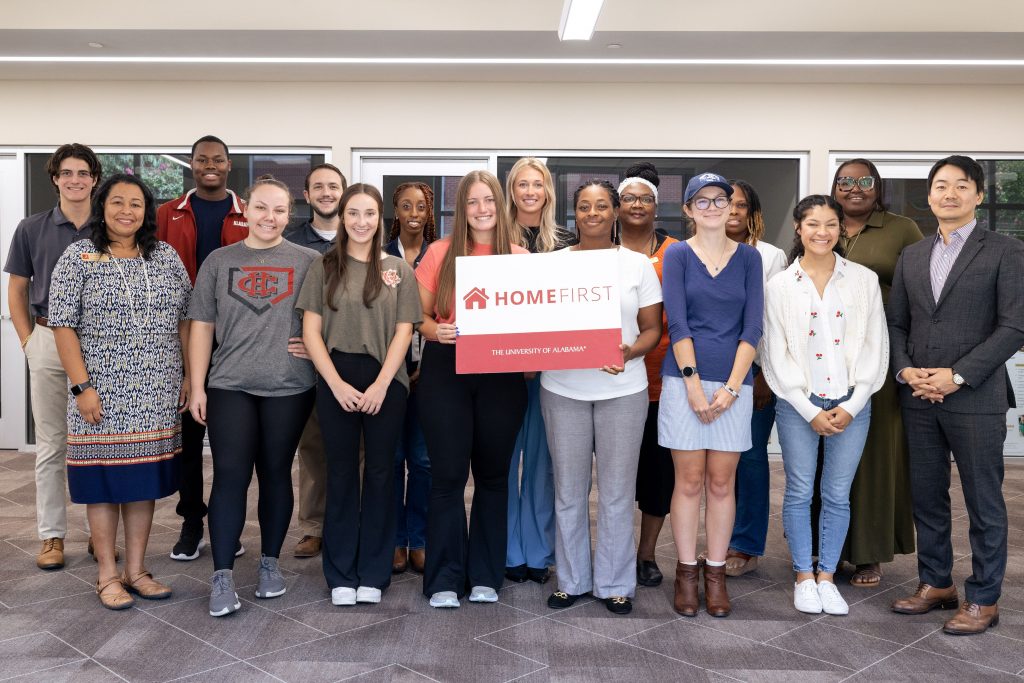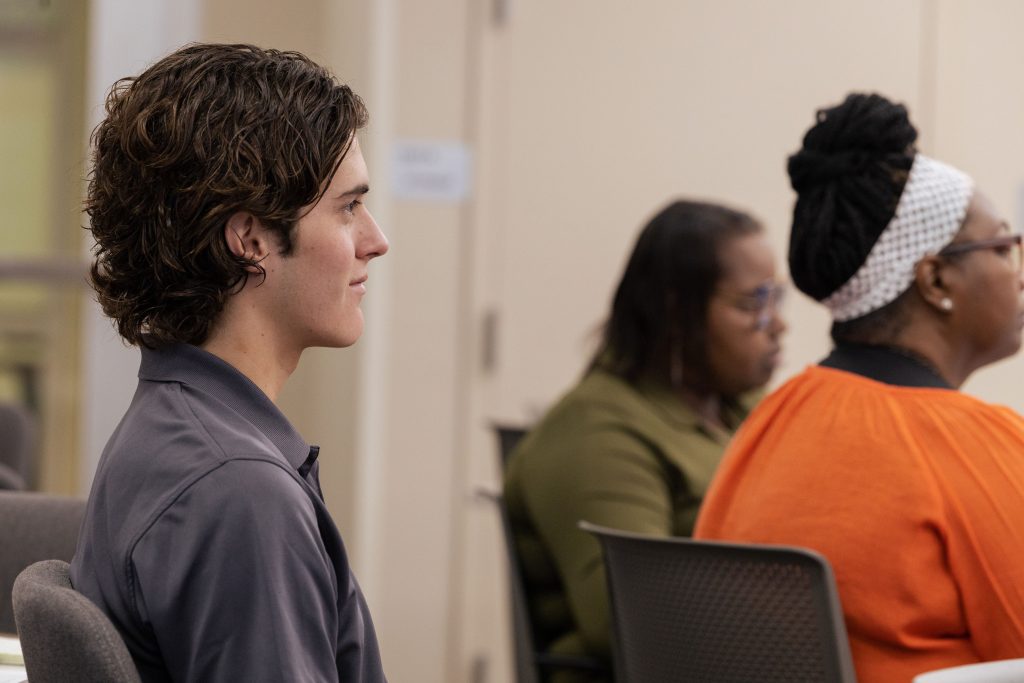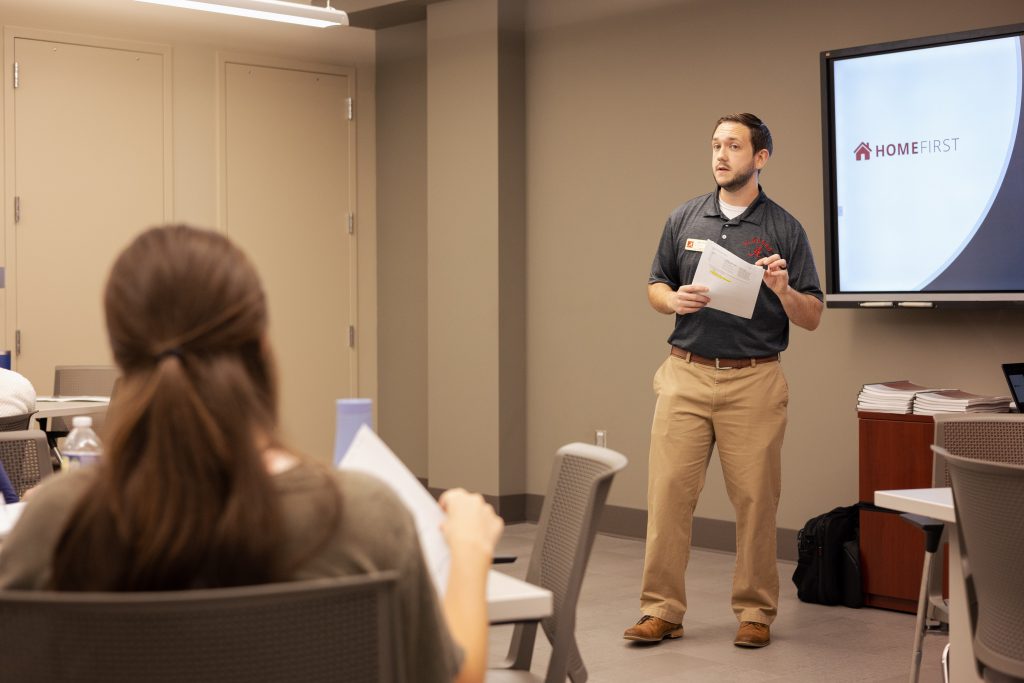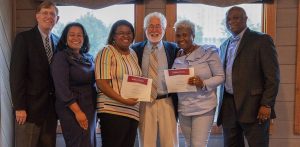By Kirsten J. Barnes
CCBP Graduate Assistant
For the second consecutive year, the Division of Community Affairs led a new faculty tour of cities and their landmarks in West Alabama and the Alabama Black Belt Region. In addition to new faculty, many staff and students in the division also attended.
The bus tour allowed participants to explore new places, meet new people and engage with new communities as part of the University’s expansion of its community-engagement capacity and opportunities in the region.
During the first day of a three-day tour, participants visited schools and museums in Eutaw (Greene County) and Greensboro (Hale County) before stopping for a session at Stillman College, a private historically black college in Tuscaloosa with close ties to and common interests with the University.
At each stop, communities shared their success stories, but also identified areas of need in hopes of encouraging UA faculty, staff and students to become more involved with this region.
For example, during a panel discussion at Robert Brown Middle School in Eutaw, Greene County School Superintendent James Carter requested help in developing programs for special needs children, telling the delegation he would appreciate their getting with him after the visit “for any suggestions on how we can better serve our special needs students in Greene Count. We also need help with our struggling students. So, if you have conducted research or have strategies we can use, I would like to hear about them.”
It was mentioned that UA’s Gear Up program was only one of several programs that partner with the Greene County Schools to prepare students for college. Several summer camp opportunities were also mentioned, among them several specifically aimed at students with social or economic hardships. Those include Alabama Summer Computer Camps (July 10–14); Art in Nature Camp (July 24–28); various reading and writing programs (June and July), Multicultural Journalism Workshop (June 2–11); Rural Health Scholars Program (May 28–June 28)’
The tour also provided opportunities for faculty and graduate students to forge new partnerships in other areas. Not only did the tour present scholars with needs, it also provided an opportunity to learn about the history of these rural areas.
In Greensboro, the tour stopped at the Safe House Museum, which was preserved as a museum after the house was used to keep the Rev. Martin Luther King Jr. safe from an attack by the Klan during the Civil Rights Movement. The home was owned by Theresa Burroughs’ mother.
On the stop, Burroughs recalled her mother making homemade biscuits for King. “My mother loved to make biscuits, and Dr. King loved biscuits. He could eat four or six,” said Burroughs, explaining that King, Albert Turner and Hosea Williams would call their home from Selma to tell them they were coming over for breakfast. “My mother would start making biscuits. By the time they drove up out there, the biscuits would be ready.”
During the stop at Stillman College, the group not only learned the history of the college, but found out about old and new collaborations. “Over the years, we have had dual degree programs with the University of Alabama,” said Dr. Mary Jane Krotzer, Stillman vice president of institutional effectiveness. She said the two schools currently have an active dual enrollment program, which allows full-time students at either school to enroll in two additional courses at the other school without paying tuition.
UA’s Vice President of Community Affairs Samory T. Pruitt, who is a member of the Stillman Board of Trustees, said the tour allowed him to see ways in which new collaborations can be started and others renewed and sustained.
“I’ve heard some of the discussions and we may not have anyone in the room today who is interested in every area that was mentioned, but we are capturing the discussion from this session and we will share it with those with similar interests when we return to campus,” Pruitt told the panelists at Stillman.
Most tour participants were seeing the Black Belt for the first time. However, a few were familiar with the areas and even the tour itself. “This was a really rewarding experience the first year,” said James Gilbreath, an instructional and reference librarian at Gorgas Library who has been at the University for three years. “This year, I’m here to give context to new faculty members.”
DAY 2, Thursday, May 10
On Day 2 of the New Faculty Community Engagement Tour the group of nearly 40 faculty, staff and students traveled to Carrollton, Ala., in Pickens County, to attend a panel discussion at Pickens County College and Career Center.
Here, panel members included representation from Whatley Health Services Inc., Pickens County Family Resource Center and Pickens County Community Action Committee and Community Development Corporation, Inc.
Although UA already has partnerships within the county, many of the new faculty members and graduate students were unfamiliar with the services offered in senior, food and family services, childcare and education.
“At the Family Resource Center we work with two demographics; one is the elderly. We manage the senior care facilities throughout the county,” said the Rev. Rodney Shamery. “We serve lunch and provide activities to the elderly in the community. The second group we serve is young people and their parents.”
Shamery, who coordinates the Fatherhood Program funded by the Children’s Trust Fund, discussed the STAR (Students at Risk) Program and the services its two locations provide to families in need.
“We help at-risk children learn the social and cognitive skills they need to be successful,” he said. “We also work with non-custodial parents to help them renew their relationship with their children. We teach them how to interact with the other parent, work with them to find employment and teach them the soft skills they need to maintain employment.”
From there the group traveled to Sumter County, where they visited the Livingston Civic Center for a panel discussion.
“I live in a town where incomes are very limited. So I want to bring people to the table,” said community activist Lovie Burrell-Parks. “I started a monthly community needs assessment that has gotten people talking about what they want to see in the community.”
Based on this needs assessment, Burrell-Parks will operate a five-day summer camp for children and their parents. “This will bring people from Panola and surrounding areas together,” Burrell-Parks said.
Like Burrell-Parks, the Rev. Bob Little, pastor of Galilee Baptist Church in Panola, has been involved in his community. Each summer for the last eight years, his church has conducted a six-week vacation Bible school.
“We teach our children oration, song, memorization, music and writing. We average about 25–30 kids and most of our kids have been on the A-B Honor Roll for the last five years,” Little said. “We teach them things that will help them be productive and successful. We have members who now write their own books.”
Additionally, the church has its own recording label and it sings every genre of music, not just gospel.
“We’re here in the backwoods of Alabama but utilizing technology to broaden our horizons,” Little said. “We are limited in resources, but we still have great potential. We have to be creative to bring resources into our community.”
The center is located on a river with a breathtaking view that participants looked out on during the panel discussion.
“This tour has been what I had hoped it would be,” said Dr. Edward Geno, M.D., faculty member in the College of Community Health Sciences’ Department of Family Medicine specializing in family, internal and rural medicine. “I heard about the efforts and the dedication of these people and how they have interacted with the college to promote some of the needs of their community. These are impressive individuals who have overcome a lot personally and in their community.”
Geno, who works to develop medical leaders, said he was most impressed by the people affiliated with Hill Hospital of Sumter County and Whatley Health Services because of the leadership required to sustain a rural medical facility or practice. “They had healthcare leadership initiatives, which is a huge need in graduate medical education,” Geno said.
In Marion, Alabama, in Perry County, the participants visited historic Judson College, which was established in 1838 specifically to educate women and continues this tradition today.
From there, the group attended a panel discussion at Marion Methodist Church, after which they visited with UA Honors College students participating in the Black Belt Experience.
“I thought the tour would be a good way to see parts of Alabama that you don’t normally see, meet people that you normally wouldn’t have the chance to interact with, and hear about some of the issues that they are facing, and to see if there are ways the University can partner with them to address those issues and maybe improve the quality of life for the people in those areas,” said Alabama Transportation Institute Outreach Director Justice Smyth IV, whose family owns a farm in Uniontown (Perry County). “This has been an eye-opening experience; not just for me, but for the group,” he said.
Day 3, Friday, May 11
The New Faculty Community Engagement Tour concluded its three-day exploration of West Alabama and the Black Belt Region with stops in Uniontown, Thomasville, and Camden, ending in Selma, where the group crossed the historic Edmond Pettus Bridge.
Uniontown (Perry County) Mayor Jamaal Hunter hosted the group at the City Recreation Center. He was joined by Emefa Butler, founder of the non-profit CHOICE (Choosing to Help Others In our Community Excel); Gilbert Sentell of Sentell Engineering; and John H. Heard III, superintendent of Perry County Schools.
About the tour participants, Dr. Samory T. Pruitt, vice president of UA’s Division of Community Affairs, said, “These are people who have gotten up at 7 o’clock in the morning and have ridden the bus for 12 hours because they were interested in hearing more about these communities and making their skillsets available to help in whatever way they can.”
Panelist discussed the needs of their area, including wastewater treatment plant concerns, transportation, education and communication.
As a result of a diminishing population, Uniontown has struggled with finding the funding needed to upgrade its water and wastewater treatment facility.
“In 2012, we were able to finally obtain funding to do some improvements to the water system and replace all of the water meters,” said Sentell. “This will allow the city to grow.”
Butler, who returned to Uniontown after living in Birmingham, founded CHOICE in 2009 in an effort to improve home community.
“It’s one thing to talk about where you are from and it’s another thing to invite people to where you are,” said Butler, who is hoping to form a communication network and solve transportation problems in her rural community.
“It only takes a little. Whatever you have, you can make a difference in the Black Belt,” Butler said. “Through community partnerships it will happen.”
She will open a Youth Resource Center on June 23 to improve “self-sufficiency, employability and the overall quality of life of the people” in Uniontown, she said. “I hope someone will donate a bus, van, or a car so that transportation will not be a barrier for our youth and young adults.”
After networking with panelists, the group traveled to Thomasville Civic Center in Clark County before touring the Golden Dragon Plant, which produces copper tubing. Afterward, they traveled to Camden, (Wilcox County), where they toured Black Belt Treasures Cultural Arts Center and made purchases of locally made crafts and artwork.
Dr. Tracey S. Hodges, assistant professor of Curriculum and Instruction, who just completed her first year in Tuscaloosa, was impressed with what she saw on the tour.
“With little resources the communities are doing great things. So, whatever the University can contribute I think they’ll just blossom,” Hodges said. “I do research in literacy and pretty much everyplace we’ve been has mentioned that as a problem.”
However, not all of the touring faculty are new to UA. Dr. Suzanne Horsley, associate professor of advertising and public relations, conducts service learning with her classes and attended the tour for ideas.
“I really don’t do community-based research, and I wanted to have a better concept of what that meant and what other partners are doing in the area,” said Horsley, who has been at UA for nine years. “It’s been really cool today to learn what other folks are doing, from supporting grant writing, to developing projects, to getting students to help figure out what the community’s needs are.”
She also welcomed the opportunity to meet people “from parts of campus that I wouldn’t normally get to talk to.”
After leaving Camden, the group visited the Selma Interpretive Center before traveling to the final panel presentation at the new Head Start program in Selma, operated by the Black Belt Community Foundation, a long time partner with and active in the Division of Community Affairs’ Center for Community-Based Partnerships.
“When this facility opened up this was a big wow factor, because children are our future, education is our future and we have a big workforce development issue in our city,” said Selma Chamber of Commerce Executive Director Sheryl Smedley.
Although Selma is a part of the Black Belt Region, it has more tourism opportunities than most cities in the regions. “Our biggest partner is the state tourism department,” said Barja Wilson, executive director of the Selma Redevelopment Authority, adding that the city is working to getting listed on more national registries to increase tourism. Additionally, a $2 million expansion of the Interpretive Center will break ground soon.
Nathaniel Shannon, a doctoral education psychology student, attended the tour all three days.
“In looking for research projects, my classmates and I found that the Tuscaloosa area was saturated with research,” Shannon said as a reason he decided to attend the tour. “I also knew that surrounding counties needed research and that there are areas where I can share my knowledge and people can share their knowledge with me.”
At the end of Day 3, veterans of the first two years of the New Faculty Engagement Tour we talked with, as well as many newcomers, came away exhausted but full of new ideas for future scholarly engagement and unanimous in their perception that their experience was a valuable one.
Typical of the reaction to the experience was the following statement by Dr. Greg Bell, assistant professor and senior data analyst in the Institute for Rural Health Research, College of Community Health Sciences:
“Please know how grateful I am to have been invited to attend the community engagement tour. I was able to attend the Black Belt session on Friday and found it to be both informative and inspirational. I finished the (very long!) day with ideas for a couple of grants that I will now be able to pursue with the benefit of local knowledge and some newfound UA resources. I hope this great program continues to thrive as a catalyst for difference-making programs and meaningful research.”

